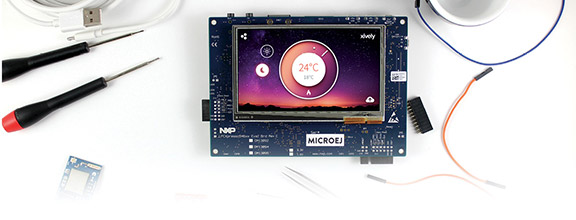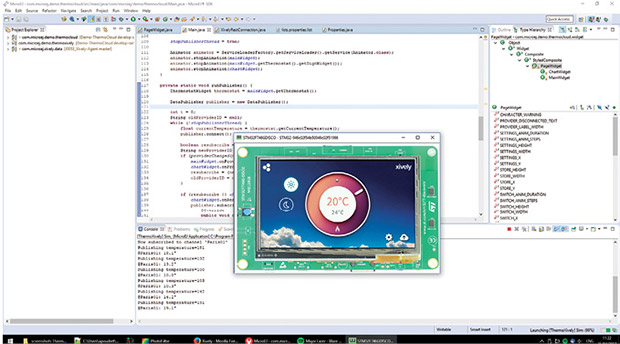
With the advent of IoT, embedded systems should gain much momentum in the immediate future. Images courtesy of MicroEJ.
Latest News
June 1, 2017
In India, incidence of road accidents causing death and injury has risen 5% in just one year; about 40% of these are caused by human error or fatigue.
Engineers in India have designed Intelliseat; an Internet of Things (IoT) device whereby sensors embedded into a seat can alert a remote monitor of a driver’s behavior and even fatigue level.
Such devices set the pace for a new wave of embedded systems that can and will be even more complex as design teams develop and introduce new products in the years ahead. The complexity of embedded systems is on the rise.
 With the advent of IoT, embedded systems should gain much momentum in the immediate future. Images courtesy of MicroEJ.
With the advent of IoT, embedded systems should gain much momentum in the immediate future. Images courtesy of MicroEJ.Dynamic Environment
Design engineers and design teams can expect virtual prototyping and simulation with regard to embedded technology to be a dynamic environment in the years ahead.
“Engineers are being challenged by shorter design cycles while needing to innovate in both design and processes to stay ahead in today’s globalized economy,” says Philipp Wallner, industry manager, Europe, Middle East and Africa (EMEA) for MathWorks. “Functionality that could previously be implemented in a system’s mechanics or electronics is increasingly being included in embedded systems. This increases flexibility in designing new industrial components and systems, but requires workflows that must support early testing and simulation using virtual prototypes, instead of more expensive physical component, machine, medical device or plant prototypes.”
Digital Twins
Wallner says having virtual representations, sometimes referred to as “digital twins,” of the components, machines or plants allows engineers to perform system simulations for early verification and use virtual prototypes to more quickly iterate their ideas.
“We’re seeing this innovative approach being used in the design of industrial packaging machinery and ventilator [and or] dialysis medical devices,” says Wallner.
Régis Latawiec, chief operating officer of MicroEJ, is upbeat about the future of embedded systems. The company provides embedded software solutions, tools and services for connected devices to design, test and prototype embedded applications. He believes the use of embedded systems will be gaining strong momentum in the near term. Such uptrend will be powered by the benefits embedded systems offer—particularly in an increasingly IoT environment.
“I expect they’ll be widely used, and very quickly,” says Latawiec. “Properly used, they can have a huge impact on a team’s development costs, agility and time to market, which, in perhaps not that order, are the three greatest demands on embedded systems design these days, especially with IoT.”
He points out that it is possible to reuse simulated prototype designs as you iterate, which facilitates speed and lowers cost.
Design Benefit
“Iteration itself is also easier because switching components just takes a click, not a soldering iron,” Latawiec adds. “That’s better for software, hardware and even the marketing team, who will want to quickly validate new concepts to fit a fast-evolving marketplace.” For a design team, it fosters more collaboration. “It softens the software team’s dependence on the hardware team, allowing them to work in parallel instead of forcing the software team to wait on certain hardware milestones,” Latawiec adds.
 Embedded technology may improve team collaboration, allowing hardware teams and software teams to be more reliant on one another and subsequently more effective and efficient.
Embedded technology may improve team collaboration, allowing hardware teams and software teams to be more reliant on one another and subsequently more effective and efficient.“And something that especially concerns design engineering firms is having a reasonable estimate of performance as early in a project’s timeline as possible,” says Rajaram Radhakrishnan, who is the senior vice president and Global Markets for the Manufacturing, Logistics, Energy and Utilities sector for Cognizant. He, too, expects a more rapid adoption of embedded systems.
He sees the demand for virtual prototyping and simulation increasing non-linearly. Such growth will be driven by consumer demand, including personalization. This means there’s a need for more options in a variety of product categories—causing a surge in demand.
With demand high, expect complex and integrated design requirements to change the game for new product introduction techniques and processes.
“These factors demand a much more agile and first-time-right design philosophy—thus necessitating the increasing demand for virtual prototyping and simulations,” says Radhakrishnan. “Additionally, I believe that an extension of simulation’s activity going right into the digital manufacturing arena for an integrated and iterative product and manufacturing process simulation will add a new dimension to the design for manufacturability paradigm.”
Preparing for the Embedded System Future
What can design engineers do now to capitalize on the expectation that embedded systems technology will become more prevalent in the near term?
“We anticipate embedded systems requirements to grow in high double digits—this is more secular than sectorial,” says Cognizant’s Radhakrishnan. “While the increased adoption and volumes in autonomous vehicles and unmanned systems will create a higher demand in high value and asset-intensive industries, the revolution in everyday low-value goods that are just $50 and above could see a huge spurt in adoption of embedded systems. Therefore, design engineers should have wide-ranging domain knowledge requirements and understanding, in addition to learning embedded systems design and development.”
He also sees an impending demand for technology expertise to accommodate demand, as well as a need to change design mindsets and philosophies.
“One of the key challenges will be to learn ‘agile software’ development, as traditional linear waterfall development models are fast becoming obsolete,” he says. “For example, there is a large number of modules and parts in the automotive industry, so a model-based development approach is a dire need. New product introduction cycles are already in danger of creeping up beyond 24-month benchmarks, as product complexity increases manifold. The use of Big Data analytics as a critical input for simulation is another area that designers will need to quickly familiarize with. Data from connected products and big data analytics can create powerful simulation opportunities—digital twins—of live products that can fundamentally transform the design efficiencies and improve product reliability.”
MathWorks’ Wallner agrees, and sees the use of digital twins to create live products at the outset of new product introductions. “Engineers should start building and using models or digital representations—digital twins, of their components and systems right from the beginning,” says Wallner. “This will enable them to perform system simulations to test and verify software on the embedded systems early in the design process. Engineers should also become familiar with production code and documentation generation from Simulink and Stateflow models for vendor-independent implementations that can be used on different embedded platforms including PLCs [power line communication] and industrial PCs. This automatic generation workflow also facilitates complying with necessary regulations and certifications such as IEC 61508 and IEC 62304.”
Latawiec says that as embedded systems become more widespread from the overall demand for real-world data collection, hardware will be commoditized the way PCs and smartphones are, and the technology will become more uniform.
“On the software side, though, embedded systems will still require specialists of two kinds of disciplines: electronics and electronics software. For the latter, there are only about half a million such specialists—embedded C programmers, in the world.” The talent pool is limited, and he says we can expect to see more high-level development environments to embedded systems.
“Building in Java instead of C, for example, increases the talent pool by 20-fold,” says Latawiec. “Engineers should keep this in mind before diving into embedded C to chase demand; keeping strong in object-oriented design, agile practices, etc. will be better in the long run.”
For more info:
Subscribe to our FREE magazine, FREE email newsletters or both!
Latest News
About the Author
Jim Romeo is a freelance writer based in Chesapeake, VA. Send e-mail about this article to [email protected].
Follow DERelated Topics






